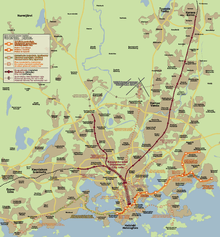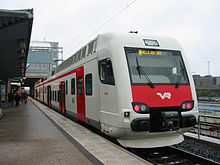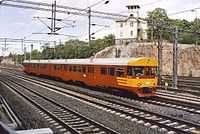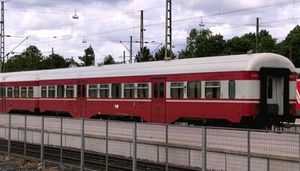Helsinki commuter rail
| Helsinki commuter rail Pääkaupunkiseudun lähiliikenne Huvudstadsregionens närtrafik | |||
|---|---|---|---|
 JKOY Class Sm5 train in Riihimäki | |||
| Background | |||
| Locale |
Uusimaa, Tavastia Proper, Päijänne Tavastia | ||
| Transit type | Commuter rail | ||
| Number of lines | 14 (4 track sections) | ||
| Number of stations | 55 | ||
| Daily ridership | 152,000 (2012 daily average)[1] | ||
| Operation | |||
| Began operation | 1969 | ||
| Operator(s) | VR Group | ||
| Technical | |||
| System length | 235 km (146 mi) | ||
| Track gauge | 1,524 mm (60.0 in) | ||
| Electrification | 25 kV / 50 Hz | ||
| Top speed | 120 to 160 km/h | ||
| |||

Helsinki commuter rail (Finnish: Pääkaupunkiseudun lähiliikenne, Swedish: Huvudstadsregionens närtrafik, proper translation Capital local traffic) is the commuter rail system serving Greater Helsinki, Finland. The network is operated by VR, the Finnish national railway company. Together with the Helsinki Metro and trams, the network forms the heart of Helsinki's public transportation infrastructure.
Trains run above ground in the Helsinki metropolitan area. Within the municipalities of Espoo, Helsinki, Kauniainen, Kerava, Kirkkonummi and Vantaa, the system uses tickets that are interchangeable with the bus, metro and tram networks managed by the Helsinki Region Transport, which was formed in 2010 by merging transport section of Helsinki Metropolitan Area Council and Helsinki City Transport. Traveling beyond Kerava and Kirkkonummi uses VR commuter tickets, which are sold in zones from A (Helsinki) to H (Lahti). The HRT-zone is completely within VR zones A, B and C.
The network is composed of 14 separate services, pictured in the network map below. They operate on all four branches of the railway lines that begin at the Helsinki Central railway station, which is where they all terminate. The system has a total of 55 stations, 14 of which are within the city of Helsinki. There are about 850 departures on weekdays. The commuter rail services carried a total 55.1 million passengers in 2011.[2]
History
In the Helsinki region, local train services have existed since the 1880s. At first, it was offered on the Main Line up to Rekola railway station.
The Coastal Line was finished in 1903. This line was built mostly with commuter traffic in mind, so immediately, housing began to develop near the stations.
During the steam era local traffic was handled with steam locomotives like Pr1 and wooden carriages with extra wide doors for rapid loading of passengers. Amount of trips increased vastly after Finland gained independence in 1917, with 4 million trips in 1920 and 9 million in 1924. Depression in 1930s hit the commuter travelling and there was only 3 million trips at lowest. By 1939 amount of trips had risen to 4 million.[3]
During the short diesel era from the end of the 1950s to the beginning of the 1970s, commuter services used DMUs of classes Dm7, Dm8 and Dm9.
The tracks were not upgraded significantly during steam or diesel eras. Both Main Line and beginning of Coastal Line up to Kirkkonummi had only dual tracks to accommodate long-distance, freight and commuter trains. The Coastal Line is still only single track between Kirkkonummi and Turku.
Current operation started to get its shape in 1969 when the first stretch, between Helsinki and Kirkkonummi, was electrified. Route designation letters were introduced on May 28, 1972. In the same year then existing commuter routes were completely electrified and a third track was added between Helsinki and Tikkurila. The third track was extended to Kerava in 1981.
The railway branch from Huopalahti to Martinlaakso, opened in 1975, was built exclusively for commuter trains, being first such line in Finland. It was later further extended to Vantaankoski.
Currently on the track sections between Helsinki and Leppävaara and Helsinki and Kerava, the commuter services use rails parallel to, but separate from those used by long-distance trains, following the S-Bahn principle. The fourth track, which enabled separate "city track traffic", was ready up to Tikkurila in 1996 and to Kerava in 2004. On the Coastal Line the section between Pasila and Leppävaara was upgraded directly from dual track to four tracks in 2001.
The railway branch from Kerava to Lahti, opened in 2006, was built as a shortcut for long-distance services, and also for the use of the new commuter service Z.
Future extensions
A new Ring Rail Line is under construction and slated for completion in August 2014. It will extend the Vantaankoski branch via Aviapolis and Helsinki-Vantaa airport to the Main Line just north of Tikkurila station. The extension is to introduce five new stations with reservations for three more. Unlike other tracks, a section of Ring Line beneath the airport will run in tunnel with tunnel stations for the airport and Aviapolis. Planning and construction of Ring Line has been done so that it will be possible to construct a branch line to Klaukkala in the future.
There are existing plans to extend the four track line to Espoo from Leppävaara. This would enable enhanced service interval to Kauklahti and also benefit long-distance traffic to Turku, which is now hampered by commuter trains on the same tracks in the section between Kirkkonummi and Leppävaara.
A major increase in capacity of Helsinki Central station has been planned as no new services can be introduced since rail capacity at Helsinki station is fully used at peak hours. The Helsinki City Rail Loop would feature an underground, drop-shaped railway starting just south of Pasila railway station and coming back from tunnel at almost same location after travelling in a loop around under Helsinki city centre. There would be three underground stations at Hakaniemi metro station, the Central railway station and Opera House. The extension is expensive and not likely to be completed before 2020.
Routes
Rantarata (The Coastal/Turku Line)
The Y line is the longest line on the Coastal Line. It operates between Helsinki and Karis with very few intermediate stops. The services run quite infrequently, with three to seven daily departures in each direction, depending on the day of the week. The train has scheduled stops at Pasila, Leppävaara and Masala and at every station between Kirkkonummi and Karis.
When Finland's first electrified line (from Helsinki to Kirkkonummi) was opened, the first service was Y. In 1987 the former Y train service ended and was replaced by S and U trains in 1988. In 2002 the route designation Y was introduced again, as after Leppävaara city tracks were finished, there was a possibility to add a fast commuter train connection to Karis. Before this a few of the S and U services continued from Kirkkonummi to Karis.
Train S runs from Helsinki to Kirkkonummi. It runs hourly in each direction. Of the two daytime trains running between Helsinki and Kirkkonummi the S trains are faster. Between Helsinki and Leppävaara, S services stop at Pasila and Huopalahti. Between Leppävaara and Kauklahti it stops at every station. Between Kauklahti and Kirkkonummi it stops only at Masala. From May 28, 1972 to May 25, 1974 the S trains were running between Helsinki and Kauniainen. The route was continued to Kirkkonummi on September 27, 1987.
Train U runs from Helsinki to Kirkkonummi. It runs once in an hour. It stops between Helsinki and Leppävaara only at Pasila and Huopalahti. Between Leppävaara and Kirkkonummi it stops on every station.
Train L runs from Helsinki to Kirkkonummi. The service runs only at nights and on weekend mornings. There is one departure from Karis on Sunday mornings. It has more stops than any other train in this system as it calls on every station between Karis and Helsinki. Before inauguration of Leppävaara city tracks and A-train in 2002, L-train was running also on daytime.
Train E runs from Helsinki to Kauklahti. It stops between Helsinki and Leppävaara only at Pasila and Huopalahti and between Leppävaara and Kauklahti at every station. It runs once in half an hour, except on Sundays, when there is no service. The route was continued in August 2007 to Kauklahti from former terminus at Espoo station. If city tracks extension from Leppävaara to Espoo station is constructed, E-train will form backbone of commuter traffic on the Coastal Line, calling at every station between Helsinki and Kauklahti.
Train A runs from Helsinki to Leppävaara. It stops at every station. It runs at 10-minute intervals during rush hours, otherwise at 20-minute intervals on working days and at 30-min intervals on weekends. The route designation A was originally used from May 28, 1972 to May 25, 1974 for Kirkkonummi service, and it was re-introduced in June 2002.
Vantaankoski Line
Train M runs from Helsinki to Vantaankoski. It runs once every 10–30 minutes and stops at every station. The service has run continuously since the track to Martinlaakso was completed in 1975. In 1991 the line was continued one stop further to Vantaankoski. In 2014 extension from Vantaankoski via Helsinki-Vantaa Airport to the Main Line will be finished, completing a circular route Helsinki-Vantaankoski-Airport-Tikkurila-Helsinki (Kehärata).
The letter M stands for Martinlaakso. When the track was continued from Martinlaakso to Vantaankoski in 1991, the route designation stayed as M. Changing the designation has been discussed from time to time, because some believe M can be confused with the logo for the metro. It is likely that route designation changes when Ring Line is completed, as it will merge routes I and M.
The Main/Riihimäki Line
Train I runs from Helsinki to Tikkurila. It runs at 10-minute intervals during rush hours and 30-minute intervals on weekend nights, stopping at every station. The I service does not run around noon or evenings on weekdays. The service was started in the mid-1990s as a rush-hour extra and its frequency was increased when the P-train was discontinued. In 2011 I-train was reduced to rush hour service. I-train in its current form will be discontinued when Ring Line is completed in 2014.
Train K runs from Helsinki to Kerava. It runs once in every 10 minutes during rush hours. The K service does not run on weekends, around noon or evenings on weekdays. It stops between Helsinki and Tikkurila at Pasila, Oulunkylä, Malmi and Puistola. Between Tikkurila and Kerava it stops at every station. An extension of the line to Nikkilä in Sipoo has been planned using a part of existing branch to Kilpilahti oil refinery. K is an original letter designation from 1972. In the 1970s and early 1980s K-trains did not stop at Puistola, Malmi and Oulunkylä. Oulunkylä was added only after completion of city tracks to Kerava in 2004.
Train N runs from Helsinki to Kerava. It stops at every station. The service runs when I and K services don't, basically at any other time of the day than rush hours. Service is provided on a steady 10 minute interval on weekdays and Saturdays and on a 15 minute interval on Sundays. Last departures at night and on mornings are run as T-trains. N is an original route dating from 1972, but until 2010 it used to be in a minor role running only on low-volume hours in early morning and in late evening.
Train T runs at night once in an hour from Helsinki to Riihimäki. There is a several hour gap in late night with no service. T stops at every station and has been doing so since 1972.
Train H runs from Helsinki to Riihimäki. It runs once in an hour. There is demand for more frequent H-train service, but this cannot be offered before a third track from Kerava to Riihimäki is constructed. The service stops between Helsinki and Kerava at Pasila and Tikkurila and between Kerava and Riihimäki at every station. Letter H is an original designation from 1972. Before 1990-1998 H-train had stops at Monni, Palopuro, Takoja, Huikko, Ristinummi and Kytömaa. These stops were cut because of low passenger numbers and H-train was disturbing other traffic by being too slow. Stops were discontinued and structures completely dismantled between 1990-1998.
Train R runs from Helsinki to Riihimäki. It runs once in an hour. All R-trains have low floor fleet and timetable requires trains to be capable of 160 km/h speed. The trains stop between Helsinki and Riihimäki at Pasila, Tikkurila, Kerava, Järvenpää, Jokela and Hyvinkää. R is an original letter from 1972 and has been running on same stop scheme since the inception with one exception which was adding Tikkurila stop in the 80s. Some of the R-trains continue to Tampere or Kouvola. A few peak hour R-train departures are run with electric locomotive and special commuter cars instead of EMUs.
The Lahti Line
Train Z runs from Helsinki to Lahti. It runs once in an hour. All Z-trains have low floors and timetable requires trains to be capable of 160 km/h speed. The service stops between Helsinki and Lahti at Pasila, Tikkurila, Kerava, Haarajoki and Mäntsälä. During the rush hours, the Z service is often crowded between Helsinki and Kerava and therefore it is run with longer trains. Two Z-trains departure from Kouvola in the morning and return there in the evening rush hour. It is run with electric locomotive and commuter cars. Also the last Z-train on the evening continues to Kouvola.
Services without letter designations
There are few rush hour departures from Riihimäki in the morning and from Helsinki in the evening rush hour, which lack letter designation, since they don't conform to any of the letter routes stop schemes. They also have only 1 or 2 daily departures per route variant. All of these are between Helsinki and Riihimäki. There used to be one of this type of train on the Coastal Line at the turn of the 21st century, but it was discontinued as the number of passengers was low.
Former services
Train P ran from Helsinki to Hiekkaharju, stopping at every station. The service was started in 1972 and stopped in August 2004. There have been plans restart the P service again on the future Ring Rail Line (Kehärata) from Helsinki via Tikkurila, Helsinki-Vantaa Airport and Huopalahti back to Helsinki.
Train G ran from Helsinki to Saunakallio. It ran six times a day in both directions and it was the only train with letter designation on the Helsinki-Riihimäki route that did not stop at Tikkurila. The service was started on June 4, 2007. It was discontinued in 2011 in order to improve management of traffic and timetable keeping on the Main Line especially during winter conditions. It used to stop at Helsinki, Pasila, Kyrölä, Järvenpää and Saunakallio.
Lengths of the lines
- Helsinki-Riihimäki 71 km (44 mi) (54 min)
- Helsinki-Lahti 104 km (65 mi) (60 min)
- Helsinki-Kerava 29 km (18 mi) (23 min)
- Helsinki-Tikkurila 16 km (10 mi) (14 min)
- Helsinki-Karis 87 km (54 mi) (1 h 7 min)
- Helsinki-Kirkkonummi 38 km (24 mi) (30 min)
- Helsinki-Kauklahti 24 km (15 mi) (29 min)
- Helsinki-Leppävaara 11 km (7 mi) (12 min)
- Helsinki-Vantaankoski 15 km (9 mi) (22 min)
Schematic of the lines
Rolling stock
Electric multiple units:
- Sm1, 50 units delivered in 1969–1973 (Valmet/Strömberg), to be phased out by Sm5 fleet
- Sm2, 50 units delivered in 1975–1981 (Valmet/Strömberg)
- Sm4, 30 units delivered in 1999–2005 (Fiat Ferroviaria/CAF/Alstom)
- Sm5, 30 units delivered in 2008–2013 (Stadler, model FLIRT). These trains are run by VR but owned by Pääkaupunkiseudun Junakalusto Oy. The first Sm5 unit started commercial operations in November 2009. A total of 42 units have been ordered and the series will replace aging Sm1-units.
- Sr1 (NEVZ) or Sr2 (SLM/ABB) locomotives and Eil/Eilf commuter traffic cars, 57 cars delivered in 1982–87 (so-called "red cars").
Commuter traffic was the last commercial traffic with wooden-bodied cars on Finnish railways. They were retired in the late 1980s when the Eil cars replaced them.
| Rolling stock of the Helsinki commuter rail services | |||||||||
|---|---|---|---|---|---|---|---|---|---|
| |||||||||
References
- ↑ http://www.vrgroupraportti.fi/passenger-services-1
- ↑ "VR Group Vuosiraportti 2011". VR Group. Retrieved 24 August 2012.
- ↑ Herranen, Timo (1988) Från hästomnibussar till metro. Helsingfors stads publikationer nr 39
External links
| ||||||||||||||||||||||||||||||



